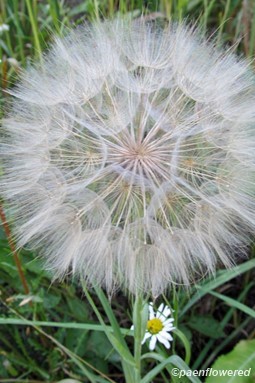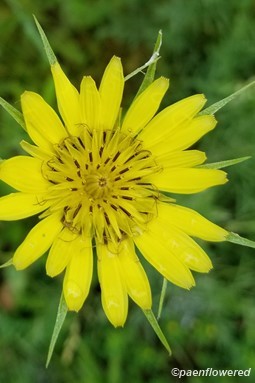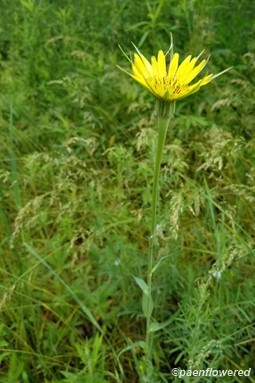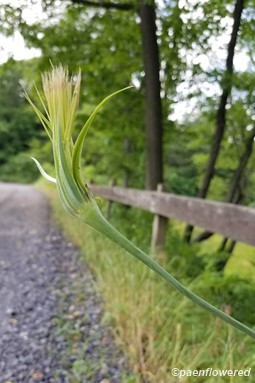Tragopogon dubius
Yellow salsify with distinctive long bracts
Tragopogon dubius yellow salsify
This wildflower is known by many other common names including wild oysterplant, yellow goat's beard, goat's beard, goatsbeard, common salsify and salsify majeur. Confusing matters is the use of many of these common names for other related species.
Yellow salsify is native to south and central Europe and western Asia, but is now widespread in North America. It grows as an annual or occasionally biennial plant. The plant grows 8-15 inches tall, but sometimes up to 3 feet. It will grow in a variety of soil types. While it is frequently found in highly disturbed sites, it also occurs in less disturbed areas, including grasslands and forests. It favors warm, sunny spots and will tolerate dryer soils than other members of its genus.
The symmetrical yellow flower that blooms in late spring and early summer is about 2 inches in diameter. The flower is a composite like other members of the Aster family. The central disk flowers are a deep yellow and ragged, while the petal-like ray flowers maybe a lighter shade of yellow and smooth. When the flowers first open the ray flowers may appear white—the yellow pigmentation develops as they mature. The thirteen long thin bracts under the flower extend beyond the petals. The flowers open early in the morning and often close up by late afternoon.
After pollination, the plant forms a seed head that resembles that of the dandelion but is a lot larger—about 3 inches in diameter. The seeds are an achene with a tuft of hair making them light enough to be distributed by the wind. The leaves can be easily mistaken for grass but they are smoother and have a more rubbery feel than grass blades. The leaves also have hairs in the axils, and exude a milky juice when broken.
Unlike other members of the genus, including the oyster plant, this species is not generally considered edible, though the roots can be dried, ground up and used as a coffee substitute. In some areas it is considered a noxious weed, but has very little economic impact because it does not spread aggressively. Most similar is the yellow goat’s beard that has shorter bracts. Meadow salsify (T. pratensis) also grows in this area but the flowers do not have the long bracts. In North America hybrids between the various related species have given rise to two new species (T. mirus and T. miscellus).
Habitat & Range
Grows in fields, along roadsides and in wasteplaces.
Present throughout the state.
Range: Found throughout North America.
Wetland code: Not classified
Phenology
Flowers May through August.
Identification Tips
The thirteen long thin bracts under the flower extend way beyond the petals.







Comments
Have you spotted this plant in your area? We'd love to hear about your experience! Share your comments or questions about the plant below. Comments are moderated before posting.